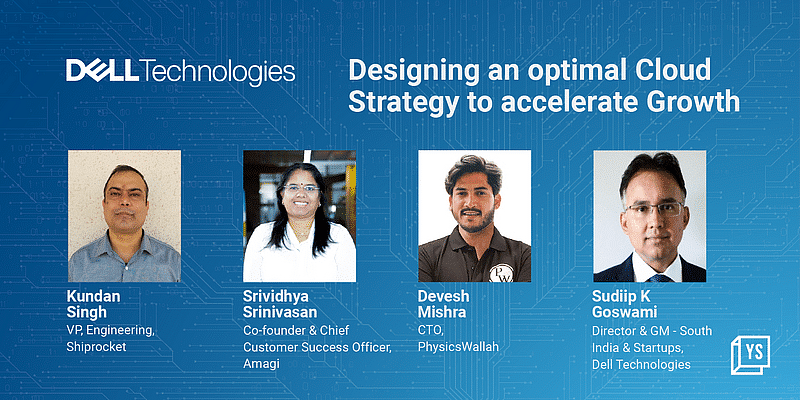As innovation and tech spending improves, we are bound to see greater outputs and changing business outcomes worldwide. More and more companies are already leveraging cloud computing to store their data and access innovative technologies to drive efficient business operations. Cybercrime magazine reports that, by 2025, over 200 zettabytes of data will be stored on the cloud.
According to IDC, cloud spending is expected to grow by over 11 percent per year over the next couple of years to reach a projected $118 billion by 2025. Reports also suggest that 84 percent of mid-to-large companies that have used some form of cloud service provider will be adopting a multi/hybrid cloud strategy by 2023.
A few leaders from the tech space came together in a roundtable discussion – hosted by YourStory and powered by Dell Technologies – to shed light on how startups can design the right cloud strategy based on their needs, optimise their cloud spending and usage, and decode why shifting to a multi/hybrid cloud is important.
The concept of cloud spending
Kundan Singh, VP of Scalability, Shiprocket, noted that the field of cloud adoption and spending has expanded enormously over the recent years. Cloud spending depends on knowing what you want to spend on and where.
“Typically, people think that there will be compute costs and storage costs,” he said, adding that there are bandwidth costs, data transfer costs among separate providers, and traffic and third-party costs to account for as well. “The first principle of scalability or observability is that you have to measure what you have to improve. So be aware of where the cost is going,” he said.
Devesh Mishra, CTO, PhysicsWallah, focused on infrastructure needs that startups will have as they set up their business, which would include cloud providers, network, storage, hardware and software needs. “To optimise our cost, we first need to understand our usage, what our need is,” he said, adding that once startups understand this, they can look into several models of cloud spending such as pay-as-you-go, saving plans, and spot instances.
Multi/hybrid cloud vs. traditional storage solutions
Srividhya Srinivasan, Co-founder and Chief Customer Officer, Amagi noted that, before Amagi, companies in media and entertainment would run out of data centres with playout service companies despite having huge storage machines that took up most of the space in a room. “Only after Amagi came in, the entire point of cloud-based linear channel origination, cloud-based delivery to OTT platforms came in,” she said.
From the media perspective, a hybrid cloud is necessary to ensure reliability, she said, adding that nobody wants their channels down if the public or private cloud they are on faces some issues.
Shiprocket’s strategy
Kundan highlighted what cloud strategy means for Shiprocket, focusing on the four pillars of scalability, ability, security, and cost optimisation. Scalability is important for the logistics and shipping software company, as is protection against any security breaches in the supply chain.
“Cost optimisation is a little tricky and gets overlooked sometimes but that’s where FinOps – the finance part of DevOps – comes into play,” he said, adding that they are also doubling down on every expenditure. He highlighted the various solutions Shiprocket has looked towards to manage costs without compromising on their security and offerings. “There are various solutions; seek out experts and peers who can guide you,” he advised startups starting their cloud adoption journeys.
Amagi’s cloud infrastructure and offerings
“Amagi’s cloud infrastructure is set up on behalf of the customer… Some of our infrastructure is multi-tenant, which means most of our customers are accommodated in a single solution, or it could be a single tenant depending on the needs of the customer,” said Srividya. She also highlighted the BYOC (bring your own cloud) model offered to their large customers, where they can bring another public cloud with their account or work on Amagi’s cloud solution.
Srividhya noted that Amagi’s platform team, DevOps team, cost optimisation team, and cloud management team are some of the most important teams working to ensure that the infrastructure is safe, secure, and cost-effective for each customer.
She advised broadcast companies to first calculate their return on investment regarding cloud, conduct a deep archive of unused content to avoid unnecessary storage costs, and hire a dedicated DevOps team to look at cloud costs and security.
PhysicsWallah’s approach to cloud
Devesh noted that, since PhysicsWallah is a two-year-old company, they haven’t yet adopted a multi-cloud strategy to store and manage their data. They started with a small cloud vendor, because “since day 1, we didn’t expect to have 1 million DAU (daily active users)”. However, as they are scaling, they have migrated their data to larger cloud vendors that offer better support, security, and system availability.
Dell Technologies’ solutions
“We are sector or vertical agnostic and my experience has been the same on all clouds,” said Sudiip K Goswami, Director & GM – South India & Startups, Dell Technologies, adding that a company in its starting stages may opt for a single cloud but might figure out constraints as it grows. The multi-cloud scenario reduces both costs and complexities, he said, highlighting that companies save up to 40 percent of their yearly costs if they do well with their multi-cloud strategy.
Dell Technologies, through their Dell for Startups program, offers startups consulting regarding various cloud strategies they can adopt based on their needs, help them set up and manage their cloud through single pane visibility, and optimise security and output of startups.
Sudiip also highlighted the NIST framework on cybersecurity that is adopted in the US, which includes steps from identifying to recovering data. Dell Technologies has developed its cloud solutions based on this framework. “If something goes wrong with your data, the cloud will not shut down. It is you who has to figure out what to do with it; the cloud will remain alive,” he said, adding that this is where an on-premises/off-premises multi-cloud strategy makes outcomes more controllable.
Advice to startups
Sudiip advised companies to read about the journeys of other startup founders who have struggled and learn how they can avoid those pitfalls. He directed startups to appoint CIOs or CTOs so they can build a strategy that is scalable for the next five years and has a cost ratio on the revenue at their current funding stage.
Srividhya highlighted the issues Amagi has had in the past with pricing, billing, onboarding of customers, and scaling. “We would have estimated a certain function to be available in a certain way but that’s not the way it would behave…. When you scale it up to a higher number, it doesn’t scale,” she shared.
Devesh believes that startups shouldn’t focus on building tech for a million users from day 1. Startups must focus on user experience and costs instead, he added. Kundan advised startups to do their due diligence wherever, be it with scalability or disaster recovery.
If you are looking to scale up, make the most of what Dell for Startups has to offer. To connect with a Dell representative,


![Read more about the article [Funding roundup] HireQuotient, Motovolt and Fresh From Farm raise early rounds](https://blog.digitalsevaa.com/wp-content/uploads/2022/11/CopyofImageTaggingnoframesEditorialTeamMaster22-1669293525576-300x150.png)



![Read more about the article [Jobs Roundup] Interested in spacetech? These openings at Bellatrix Aerospace might help your career to take o](https://blog.digitalsevaa.com/wp-content/uploads/2021/02/spacetechimage-1600942442854-300x150.jpg)
![Read more about the article [Matrix Moments] Why two ex-Flipkart executives decided to start business-in-a-box platform Protonn](https://blog.digitalsevaa.com/wp-content/uploads/2021/07/Imaged48w-1627665601265-300x150.jpg)


![Read more about the article [The Turning Point] How Sridhar Vembu-led Zoho came back stronger after dotcom burst](https://blog.digitalsevaa.com/wp-content/uploads/2022/05/MalvikaCopyofImageTagging88-1653727945479-300x150.png)